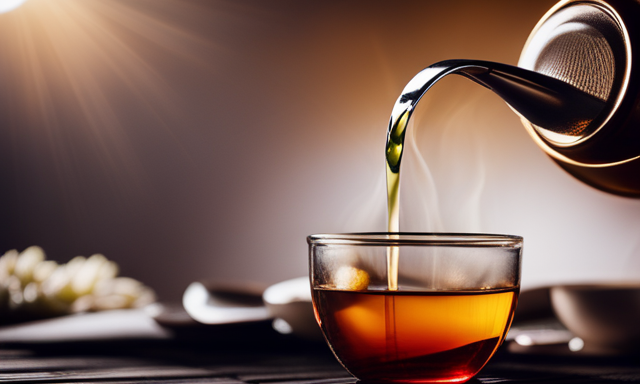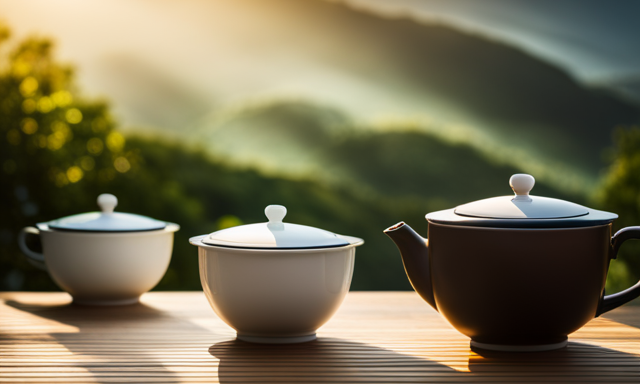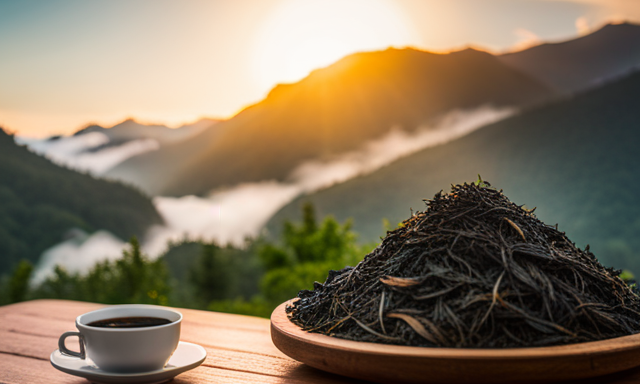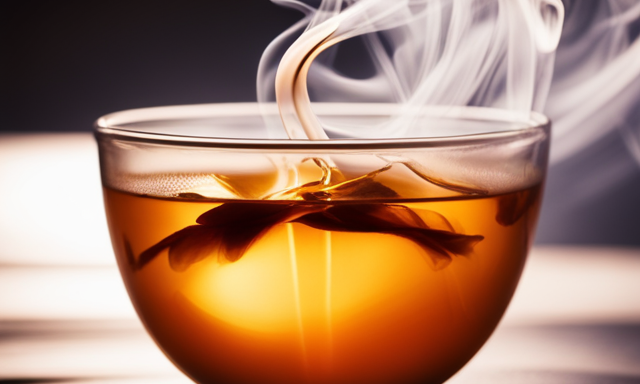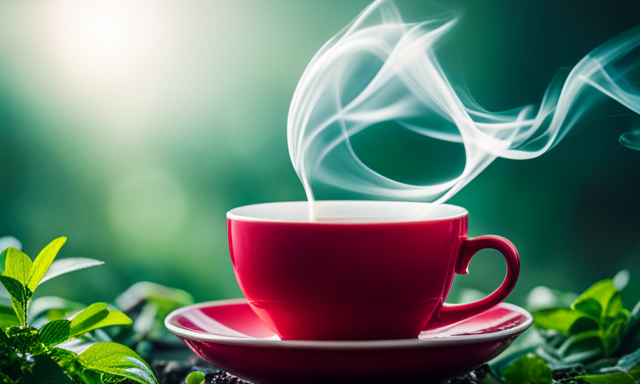As a tea enthusiast, I often find myself pondering the perfect steeping time for different types of tea. Oolong tea, with its unique flavor profile and varying degrees of oxidation, presents a delightful challenge. Finding the right balance between strength and subtlety is crucial when brewing oolong tea. It’s like creating a symphony of flavors, where each note must be perfectly timed and executed.
In this article, we will explore the art of steeping oolong tea and unveil the secrets to achieving the ideal cup. From understanding the characteristics of oolong tea to choosing the right water temperature and determining your desired strength, we will delve into the precise details that make all the difference.
Whether you prefer lighter or darker oolong teas, we will provide you with the recommended steeping times to extract the best flavors. And for those seeking a stronger flavor, we will even discuss the technique of using multiple infusions.
So, join me on this journey as we unlock the mysteries of steeping oolong tea and discover the joy of enjoying a perfectly brewed cup.
Key Takeaways
- Steeping time greatly impacts the taste of oolong tea, with shorter steeping times resulting in a lighter and floral flavor, and longer steeping times resulting in a bitter and astringent flavor.
- Experimenting with different steeping times allows tea enthusiasts to unlock the different flavor profiles and find their preferred strength and taste.
- Using filtered water enhances the flavor of oolong tea and ensures a satisfying tea experience by removing impurities from the water.
- To fully appreciate the complex taste of oolong tea, it is recommended to allow the tea to cool slightly before sipping, as this avoids burning the taste buds and enhances the flavor nuances.
Understanding the Characteristics of Oolong Tea
Oolong tea is known for its unique characteristics, making it a delightful beverage to steep and savor. Understanding oolong tea flavors is essential to fully appreciate its complexity.
This tea falls in between black and green tea, offering a wide range of flavors, from floral and fruity to toasty and nutty.
The benefits of drinking oolong tea are numerous. It contains antioxidants that support overall health, boosts metabolism, aids in weight management, and promotes heart health. Additionally, oolong tea may help regulate blood sugar levels and improve brain function.
To savor the true essence of oolong tea, choosing the right water temperature is crucial. This will ensure that the delicate flavors are properly extracted without becoming bitter or overpowering.
Choosing the Right Water Temperature
For a more flavorful cup, it’s crucial to select the appropriate water temperature when brewing your oolong tea. Choosing the right tea leaves is just the first step; using the right water temperature is equally important. The water temperature affects the extraction of flavors from the tea leaves, and different oolong teas require different temperatures. Here is a table to help you choose the right water temperature for your oolong tea:
| Oolong Tea Type | Water Temperature |
|---|---|
| Light Oolong | 180°F – 190°F |
| Medium Oolong | 190°F – 200°F |
| Dark Oolong | 200°F – 205°F |
| Roasted Oolong | 205°F – 212°F |
| Aged Oolong | 195°F – 205°F |
Using filtered water also has its benefits. It removes impurities that can affect the taste of your tea, ensuring a purer and cleaner flavor. Once you have chosen the right water temperature, you can proceed to the next step of preparing your tea leaves.
Preparing Your Tea Leaves
To prepare your tea leaves, start by gently placing them in a teapot, allowing their delicate aroma to fill the air.
Choosing the right teapot is crucial in ensuring the best flavor and experience with your oolong tea. Porcelain or ceramic teapots are ideal as they retain heat well and won’t interfere with the tea’s flavor.
Once you’ve selected your teapot, add hot water to rinse the leaves and awaken their flavors. Let the leaves steep for about 2-3 minutes, but remember that steeping time can vary depending on personal preference.
Oolong tea offers a range of benefits, including boosting metabolism and promoting heart health. Its unique combination of oxidation levels produces a complex flavor profile that can be enjoyed at any time of the day.
Determining your desired strength is the next step to achieving the perfect cup of oolong tea.
Determining Your Desired Strength
Once you’ve mastered determining your desired strength, a world of rich and nuanced flavors awaits in your cup.
Finding the ideal brewing vessel is crucial in achieving the perfect oolong tea experience. Different vessels, such as gaiwans or Yixing clay teapots, can enhance the taste and aroma of your brew.
Experimenting with various oolong tea blends is also essential in discovering your preferred strength. Whether it’s a floral Tie Guan Yin or a roasted Da Hong Pao, each blend brings its own unique characteristics to the table. By exploring these blends, you can find the perfect balance of flavors that suits your palate.
Transitioning into the next section about steeping times for lighter oolong teas, it’s important to understand the delicate nature of these teas.
Steeping Times for Lighter Oolong Teas
Lighter oolong teas bring out their delicate flavors and aromas in just a matter of minutes, making them a quick and delightful option for tea enthusiasts. To achieve the perfect cup of light oolong tea, it is important to follow the right steeping techniques. Here are some guidelines to ensure you get the most out of your tea:
- Use water heated to around 180°F (82°C) to preserve the delicate flavors.
- Steep the leaves for 2-3 minutes to allow the flavors to develop without becoming overpowering.
- Experiment with shorter or longer steeping times to find your preferred taste.
- Consider using a gaiwan or small teapot to fully appreciate the nuanced flavors of light oolong teas.
Steeping times for medium oolong teas will vary slightly, allowing for a bolder flavor profile while still maintaining the tea’s inherent complexities.
Steeping Times for Medium Oolong Teas
When brewing medium oolong teas, it is important to choose appropriate teaware that allows the leaves to unfurl and release their full flavor. A gaiwan or a small porcelain teapot would be ideal for this purpose.
As for the steeping time, it is generally recommended to steep medium oolong teas for around 3 to 5 minutes. This allows the tea leaves to fully infuse the water and create a balanced flavor profile.
Additionally, medium oolong teas are known for their numerous health benefits, such as boosting metabolism and aiding digestion. They are also rich in antioxidants, which can help promote overall well-being.
Now, let’s move on to exploring the steeping times for dark oolong teas, where we will uncover a deeper and more robust flavor profile.
Steeping Times for Dark Oolong Teas
To fully savor the rich and robust flavor of dark oolong teas, you’ll want to let the leaves steep for a slightly longer period of time, around 5 to 7 minutes, allowing the full depth and complexity of the tea to unfold in each sip. Dark oolong teas are known for their bold and intense flavor profiles, which can range from earthy and woody to fruity and floral. By steeping the leaves for a longer duration, you are able to extract more of the tea’s nuanced flavors. To enhance your steeping technique, consider using water at a temperature of around 195°F (90°C) to 205°F (96°C), which helps to bring out the tea’s full-bodied characteristics. Furthermore, adjusting the steeping time within the 5 to 7-minute range can allow you to customize the strength of the tea to your preference. Next, we will explore how using multiple infusions can further intensify the flavor.
Using Multiple Infusions for Stronger Flavor
Steeping dark oolong teas for multiple infusions not only intensifies their flavor, but also allows for a more nuanced and complex tasting experience. This technique involves steeping the tea leaves multiple times to extract the full potential of their flavors.
Each infusion brings out different layers of taste, revealing subtleties that might have been missed in a single steep. The first infusion tends to be lighter and more floral, while subsequent infusions deepen in flavor, becoming richer and more robust.
By using multiple infusions, you can fully explore the complex notes and aromas that oolong tea has to offer. Experimenting with different steeping times for each infusion can further enhance the flavor extraction, allowing you to tailor the taste to your preference.
Now, let’s delve into the next section and explore the art of experimenting with steeping times.
Experimenting with Steeping Times
Delving into the art of experimenting with steeping times allows me to unlock a world of flavor possibilities, leaving my taste buds pleasantly surprised. By trying different steeping methods and comparing the flavor profiles of various oolong teas, I can discover the perfect balance of taste and aroma. To illustrate this, I have created a table below showcasing my findings:
| Steeping Time (in minutes) | Flavor Profile |
|---|---|
| 2 | Light and floral |
| 4 | Smooth and mellow |
| 6 | Rich and robust |
| 8 | Bold and intense |
| 10 | Bitter and astringent |
Through my experimentation, I have learned that steeping times greatly impact the taste of oolong tea. From lighter and floral to bolder and more intense flavors, each steeping time offers a unique experience. Now that I have explored the fascinating world of experimenting with steeping times, it’s time to move on to enjoying my perfect cup of oolong tea.
Enjoying Your Perfect Cup of Oolong Tea
Indulging in the exquisite flavors of a perfectly brewed cup of oolong tea is like savoring a moment of pure bliss. The aroma alone can transport you to a tranquil oasis as you take that first sip.
To truly enjoy your cup of oolong tea, finding the perfect teapot is essential. Look for a teapot that is made of high-quality materials, such as ceramic or glass, to ensure that it doesn’t alter the taste of the tea. Additionally, consider the size of the teapot, as a smaller one will allow the leaves to steep more evenly.
Here are five essential tips to enhance your oolong tea experience:
- Use filtered water to bring out the best flavors.
- Experiment with different steeping times to find your preferred strength.
- Allow the tea to cool slightly before sipping to fully appreciate its complex taste.
- Pair your oolong tea with complementary foods, such as light pastries or fresh fruit.
- Take the time to fully enjoy each sip, savoring the unique flavors and aromas that oolong tea has to offer.
Frequently Asked Questions
Can I use the same steeping time for all types of oolong teas?
Steeping time for different types of oolong teas can vary. Factors like leaf size, oxidation level, and personal preference can affect flavor during steeping. It’s important to experiment and find the perfect balance for your desired taste experience.
Should I steep oolong tea for longer if I want a stronger flavor?
To enhance the natural flavors of oolong tea and achieve a stronger taste, steeping time is not the only factor. Instead, focus on using hotter water to unlock the tea’s full potential.
Is it possible to over steep oolong tea?
Yes, it is possible to over steep oolong tea. Over steeping can result in a bitter taste and astringent flavor. To avoid this, it’s important to follow the best steeping techniques and not exceed the recommended steeping time.
What is the recommended amount of tea leaves to use for a single cup of oolong tea?
When it comes to a single cup of oolong tea, the recommended amount of tea leaves to use is around 2 teaspoons. This ensures a balanced flavor and allows for the proper steeping time and tea to water ratio.
Can I reuse oolong tea leaves for multiple infusions?
Yes, you can definitely reuse oolong tea leaves for multiple infusions. It actually has many benefits, such as extracting different flavors and aromas with each steep, making it a cost-effective and enjoyable experience.
Conclusion
After experimenting with various steeping times, I have come to the conclusion that finding the perfect cup of oolong tea is like discovering a hidden treasure. Each steeping time unlocks a different level of flavor and aroma, allowing you to tailor your tea to your personal preferences.
Just like a skilled explorer, you must navigate the delicate balance between strength and subtlety. So go forth, fellow tea enthusiasts, and embark on your oolong tea adventure. May you find the golden elixir that awakens your senses and brings joy to every sip.


